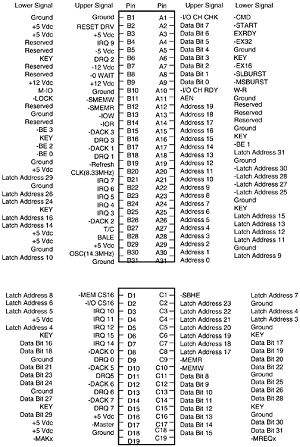EISA Bus
The Extended Industry Standard Architecture (EISA) standard was announced in September 1988 as a response to IBM's introduction of the MCA bus—more specifically, to the way IBM wanted to handle licensing of the MCA bus. Vendors did not feel obligated to pay retroactive royalties on the ISA bus, so they turned their backs on IBM and created their own buses.
The EISA standard was developed primarily by Compaq and was intended to be its way of taking over future development of the PC bus from IBM. Compaq knew that nobody would clone its bus if it was the only company that had it, so it essentially gave the design to other leading manufacturers.
Compaq formed the EISA committee, a nonprofit organization designed specifically to control development of the EISA bus. Very few EISA adapters were ever developed. Those that were developed centered mainly around disk array controllers and server-type network cards.
The EISA bus was essentially a 32-bit version of ISA. Unlike the MCA bus from IBM, you could still use older 8-bit or 16-bit ISA cards in 32-bit EISA slots, providing for full backward-compatibility. As with MCA, EISA also allowed for automatic configuration of EISA cards via software.
The EISA bus added 90 new connections (55 new signals plus grounds) without increasing the physical connector size of the 16-bit ISA bus. At first glance, the 32-bit EISA slot looks a lot like the 16-bit ISA slot. The EISA adapter, however, has two rows of stacked contacts.
The first row is the same type used in 16-bit ISA cards; the other, thinner row extends from the 16-bit connectors. Therefore, ISA cards can still be used in EISA bus slots. Although this compatibility was not enough to ensure the popularity of EISA buses, it is a feature that was carried over into the VL-Bus standard that followed. The physical specifications of an EISA card are as follows:
-
5'' (127mm) high
-
13.13'' (333.5mm) long
-
0.5'' (12.7mm) wide
The EISA bus can handle up to 32 bits of data at an 8.33MHz cycle rate. Most data transfers require a minimum of two cycles, although faster cycle rates are possible if an adapter card provides tight timing specifications. The maximum bandwidth on the bus is 33MBps, as the following formula shows:
8.33MHz x 4 bytes (32 bits) = 33MBps
Figure 1 describes the pinouts for the EISA bus. Figure 2 shows the locations of the pins; note how some pins are offset to allow the EISA slot to accept ISA cards. Figure 3 shows the card connector for the EISA expansion slot.
 |  |  |